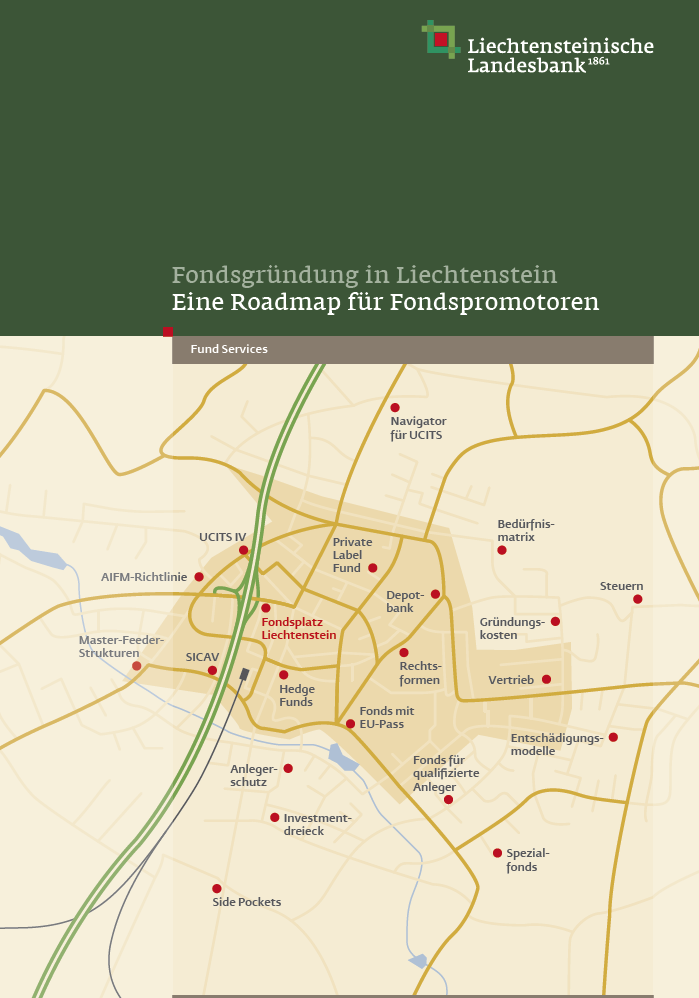Information checkedInformation unaudited Information geprüft Information ungeprüft The documents that shaped LLBʼs fund business
Anyone interested in investment funds in Liechtenstein will quickly come across Urs Müllerʼs publications. Some may ask: publications? Indeed – over the course of his career, Urs has worn many hats, from bank employee to various management roles, Executive Board, and even author.
As early as 1997, he co-authored LLB Publication Series No. 22, “The Liechtenstein fund centre”, which became a kind of map for many financial experts navigating the then still-emerging Liechtenstein fund sector. But that wasnʼt all – he followed up in 2010 with “Fund formation in Liechtenstein – a road map for fund promoters”, which served as a hands-on guide for those looking to establish themselves in the Liechtenstein fund market.
Memories of a fellow traveller
Former LLB Director Karlheinz Heeb also remembers Urs Müllerʼs works well:
“Already in LLB Publication Series No. 22 (1997), Urs Müller, together with Dr. Franco Taisch, laid the foundations for Liechtenstein as a fund centre. This well-researched work has played a key role in enabling LLB to further strengthen its leading position in this field.”
Karlheinz Heeb shares a special memory with Urs Müller and Erwin Vogt: in 1996, they travelled together to the Cayman Islands to visit LLBʼs newly founded subsidiaries, LLB Fund Management (Cayman) Ltd. and LLB Portfolio Invest (Cayman) Ltd., in George Town[JH1] . However, their return journey did not go as planned:
“In Miami, where we had a stopover, a sandstorm was announced. On the spur of the moment, we decided to spend the night there instead of continuing our journey as planned. It turned out to be an unforgettable evening – one of those spontaneous experiences that stay with you.”
Karlheinz Heeb, former director of LLB
After three decades of dedicated service to LLB and Liechtensteinʼs fund industry, Urs Müller is now embarking on a new chapter. On a personal level, Karlheinz Heeb has always known and valued his long-time colleague as a down-to-earth lawyer and a determined banker.
He greets him here in this context for the last time:
The road to the fund centre
In the 1990s, Liechtenstein was still an emerging fund centre, with its legal framework under development and its international standing yet to be established. LLB recognised the potential early on and worked on building a solid foundation while other financial hubs were already advancing.
A key milestone came in 1997 with the publication of LLB Publication Series No. 22, co-authored by Urs Müller and Dr. Franco Taisch. This work explored the legal framework of Liechtenstein as a fund centre and became a trusted reference for industry experts.
By 2010, Liechtenstein had evolved into a serious competitor to financial centres such as Luxembourg, Switzerland, Malta, and Ireland. Political stability, EU compatibility, and tax advantages made it an attractive location. However, the implementation of the UCITS IV Directive (Directive on Undertakings for Collective Investment in Transferable Securities) and the AIFM Directive (Directive on Alternative Investment Fund Managers) reshaped the regulatory landscape – precisely the focus of Müllerʼs second book.
From rule book to road map
“A classic is a book which people praise and donʼt read.” Urs Müller opened his second publication with this quote from Ernest Hemingway. Many books are read once and then left on the shelf. Others become long-term companions – pages dog-eared, revisited time and again. Urs Müllerʼs publications belong to the latter category. While the 1997 treatise explained the legal framework, the 2010 road map served as a practical how-to guide. It walked fund founders through the process step by step, helping them set up a fund in Liechtenstein – without falling into the usual pitfalls.
A closer look at the books
What makes these publications so valuable? They bridge a gap, transforming a complex topic into an accessible one: a concise, clear, and practice-oriented guide to the opportunities and advantages of Liechtenstein as a fund centre.
“The Liechtenstein fund centre” (1997)
- Legal bases: Detailed explanation of the Investment Undertakings Act (IUA) and the associated Investment Undertakings Ordinance (IUO).
- Legal structures: Possible legal forms for investment undertakings.
- Investor protection: Measures for the protection of investors.
- Authorisation and distribution: Requirements for the authorisation and distribution of investment undertakings.
“Fund formation in Liechtenstein – a road map for fund promoters” (2010)
This publication explains why a private label fund (a fund launched by a bank or management company for an external client) is attractive in Liechtenstein, which success factors are crucial and how a Liechtenstein SICAV (société dʼinvestissement à capital variable, a flexible investment company) works.
- Overview of the regulatory framework: What makes Liechtenstein particularly attractive?
- Structured graphics and navigators: A look at fund architecture, asset classes, and fund types with a EU passport.
- Practical tips: How can foreign funds be transferred to Liechtenstein? What advantages does a Liechtenstein SICAV offer?
- Tax and regulatory aspects: What role do UCITS IV and the AIFM Directive play? What does the cost structure of a fund look like?
)
)
)
)
)
